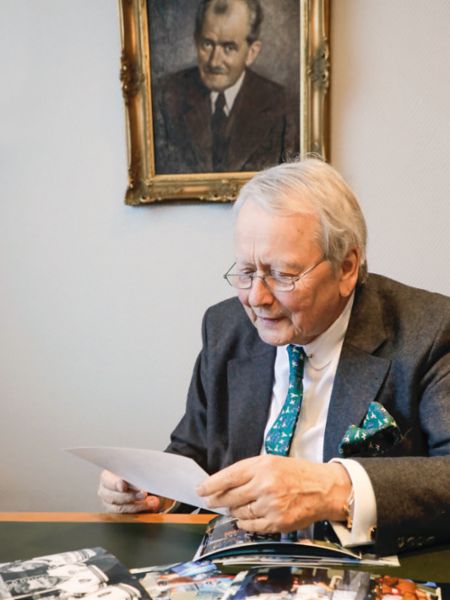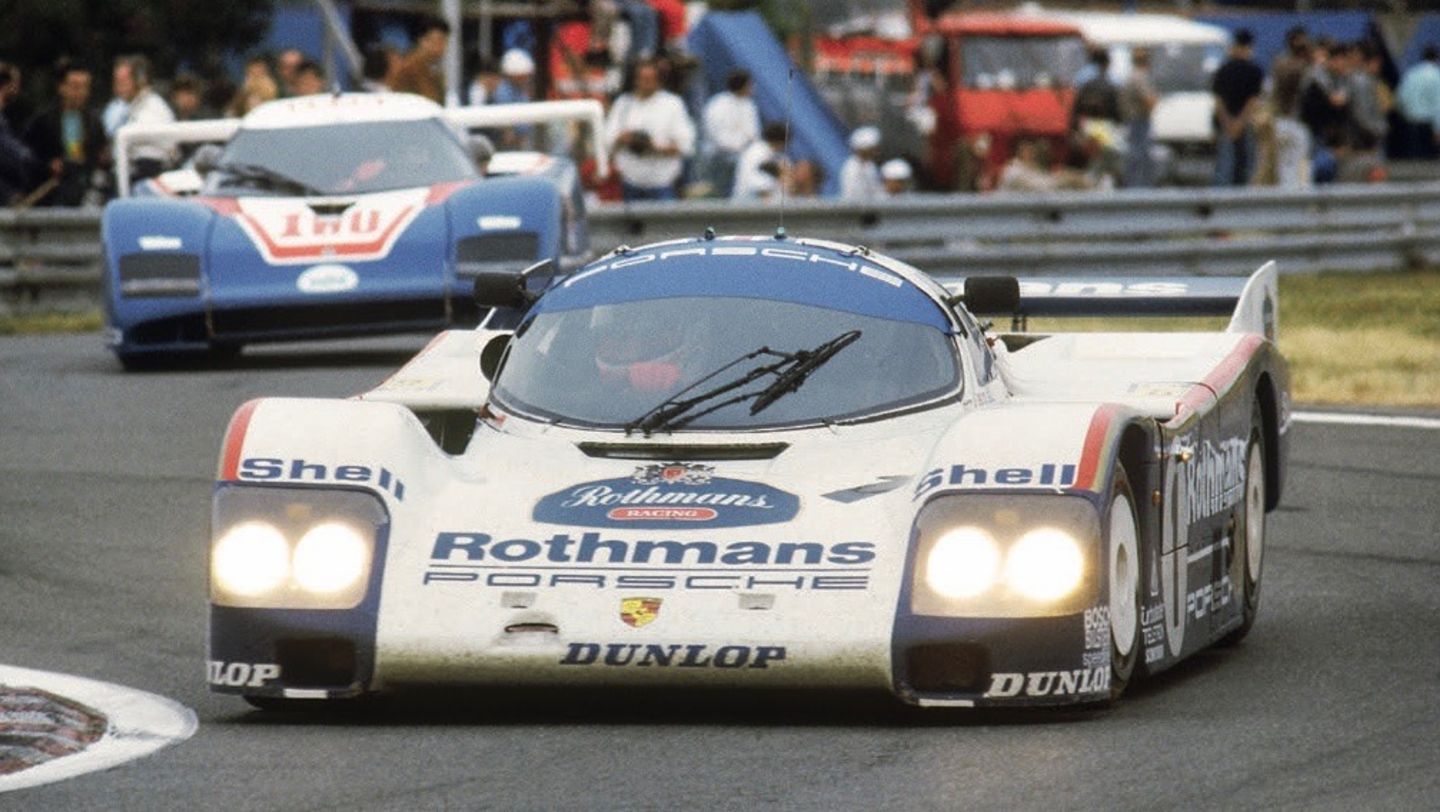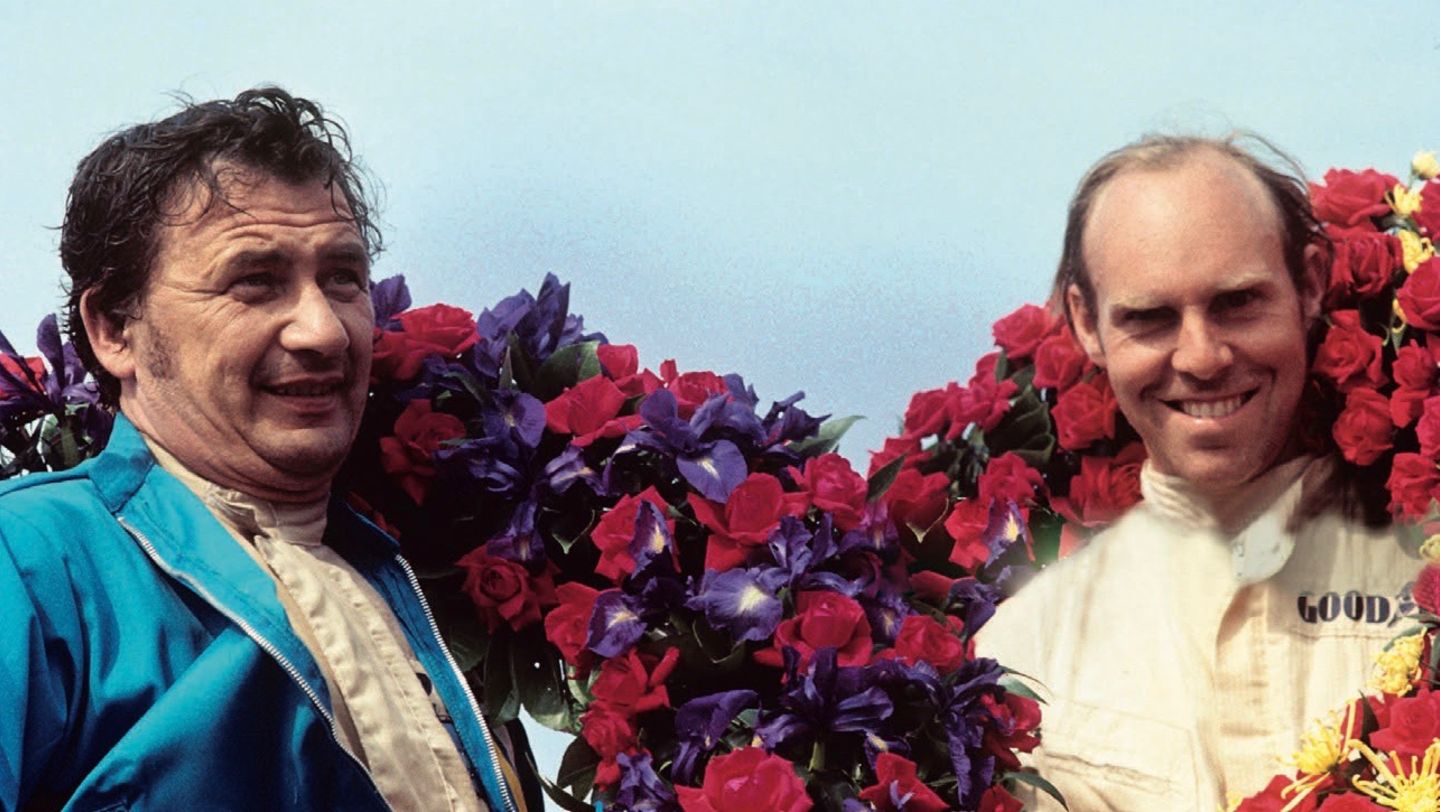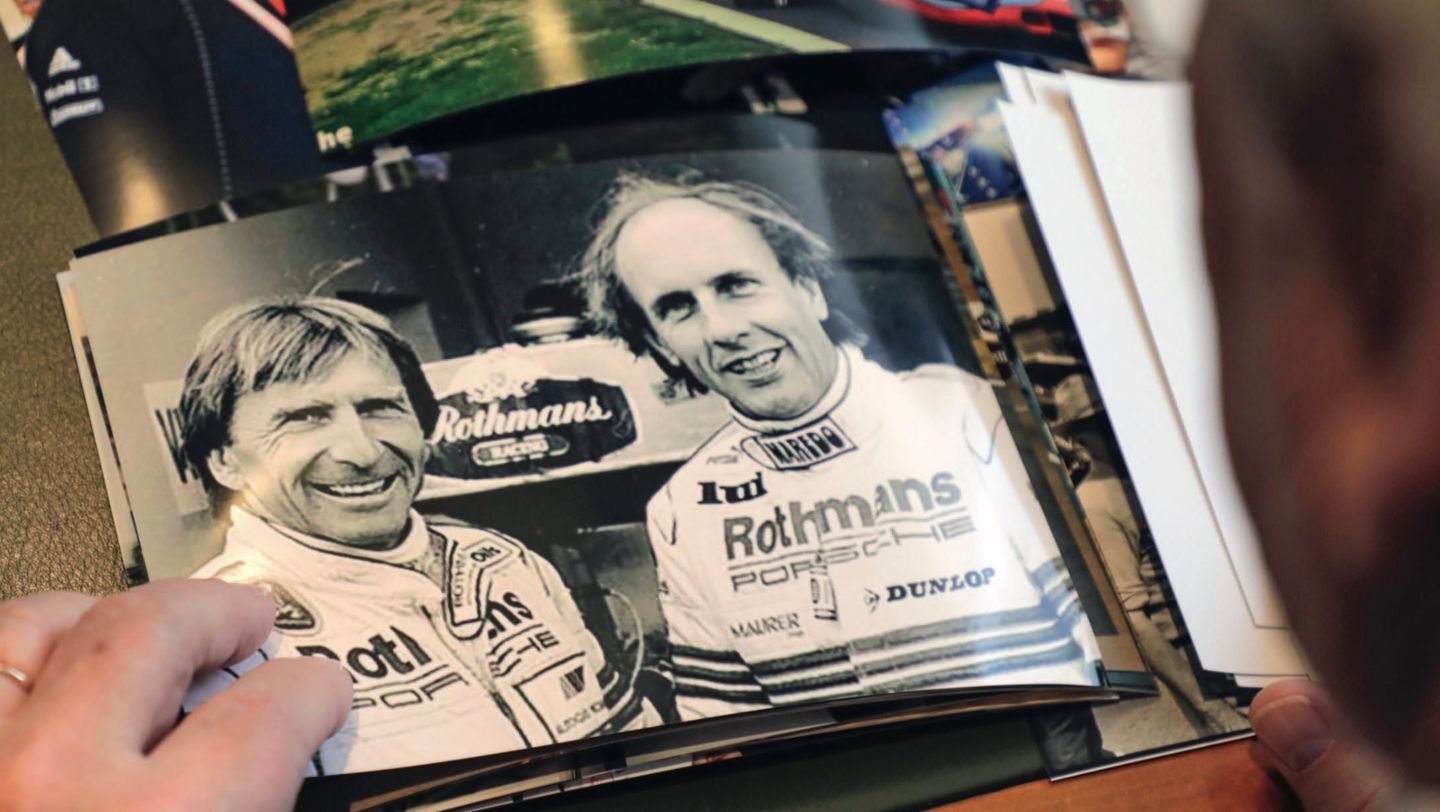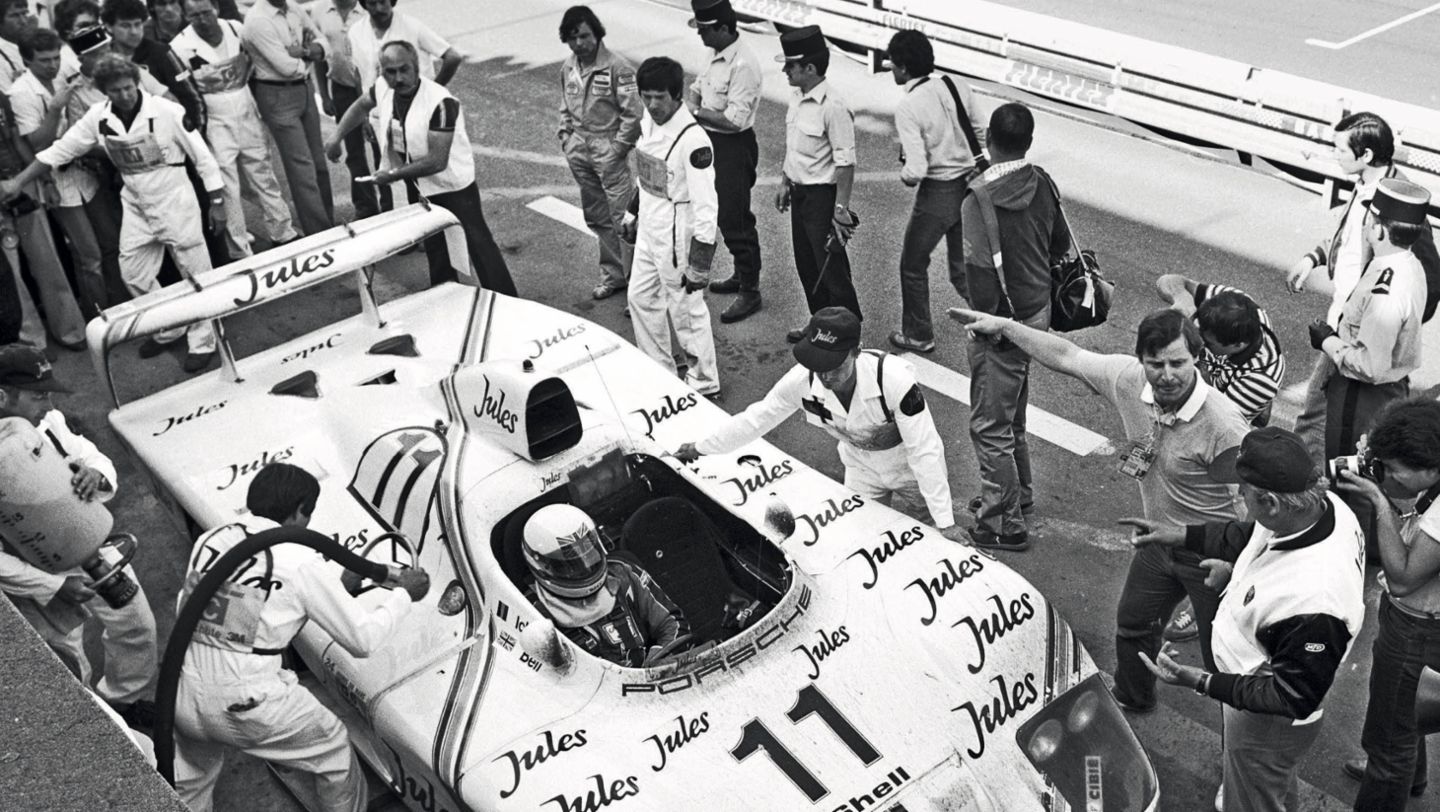This blog will expand on themes and topics first mentioned in my book, "The Automobile and American Life." I hope to comment on recent developments in the automobile industry, reviews of my readings on the history of the automobile, drafts of my new work, contributions from friends, descriptions of the museums and car shows I attend and anything else relevant. Copyright 2009-2020, by the author.
Popular Posts
-
My 1971 Porsche 911T Targa Written for younger readers: Sports car is an automobile designed more for performance than for carrying passeng...
-
Hi folks -- I was visiting with Ed Garten on Friday morning at a local Panera in Beavercreek, Ohio when Ed noticed that a Mary Kay Cadillac ...
-
So what is a rat rod? These are becoming increasingly popular, as witenssed by the several at the Friday night cruise in and today at the C...
-
Raising an Alarm The wave of auto thefts in the early 1970s and the failure of manufacturers to make prod...
-
Hi Folks -- Visiting back in Centerville, I read the Dayton Daily News this rainy Easter morning and found an rather lengthy article on Donk...
Sunday, June 28, 2020
Sleeping Around: Custom Cars and Their Custom Small Trailers
Friday, June 26, 2020
Fifty Years Ago, Steve McQueen Started Filming Le Mans
Scene 1

Fifty years ago, Steve McQueen began shooting his movie epic Le Mans—the most famous film sequence featuring a 911. Today, the new Porsche 911 Targa 4S Heritage Design Edition would likely be perfectly cast for the role.
Scene 2

No words: McQueen relies on the power of images when it comes to the film character Michael Delaney. The first half hour of the film gets by without dialogue, as Delaney arrives in Le Mans in his Porsche 911 S. The car is the star of this legendary intro. At the 2020 photo shoot in the style of the McQueen years, the new Porsche 911 Targa 4S Heritage Design Edition takes center stage.
“As far as he was concerned, Porsche was the best car in the world.”Costar Siegfried Rauch on Steve McQueen
With 331 kW (450 hp; 911 Targa 4S Heritage Design Edition: Fuel consumption combined 10.3 – 9.9 l/100 km; CO2 emissions combined 235 – 227 g/km), this special model offers two and a half times as much power as the 1970 film original. The Christophorus backdrop is modeled on the renowned Porsche workshop in Teloché near the French racetrack—the team’s Le Mans base until the 1980s.
Scene 3

Original props: in Le Mans, the German Johann Ritter is one of McQueen’s rivals. Ritter’s helmet from the shoot fifty years ago is now to be found on the cherry metallic paintwork of the new Targa 4S. While a first-generation 911 enlivens the scene in the background, the latest 911 interpretation presents its tail end, featuring a continuous strip of lights and four silver sport tailpipes. Trunk lid grilles in glossy black and decorative elements illuminated in white are the calling card of the Heritage Design Edition, which has been limited to 992 vehicles.
Scene 4
Authentic fiction: Le Mans is made particularly fascinating by its numerous film shots from the real twenty-four-hour race of 1970, which are seamlessly interwoven with the storyline. The race car from McQueen’s film company, Solar Productions—a Porsche 908/02 Spyder—drove along as a camera car and exposed kilometers of footage of real racing scenes.
“His love of racing was infectious.” Chad McQueen on his father Steve McQueen
The Porsche 911 Targa 4S Heritage Design Edition is a loving nod to Porsche history, with gold-colored lettering on the Targa bar and the rear. The unique interior features club leather and corduroy in Atacame Beige. The instrument cluster and Sport Chrono stopwatch provide further nostalgic reminiscences in the cockpit.
Scene 5

Final: the race is over. A short look back at the guest star in the studio—a first-generation Porsche 911 Coupé. The garage door then opens and releases the new 911 Targa 4S Heritage Design Edition onto the asphalt of the road, where it will write its own story.
Le Mans: no words
With Le Mans, Steve McQueen realized his very own idea of a film about race-car drivers: actions, gestures, and looks count for more than words. In the very last scene, when rivals Erich Stahler (Siegfried Rauch) and Michael Delaney (Steve McQueen) cross the finish line in the midst of a roaring crowd—neither victorious, yet both full of respect for each other—a gesture with just two fingers is enough to say it all. Really great cinema can be so ingeniously simple. The movie premiered in 1971 in Indianapolis, where McQueen had grown up. Le Mans was not a box-office success, however. It was too experimental for its time but became a cult classic and blueprint for all racing movies that followed.
Info
Text first published in the Porsche customer magazine Christophorus, No. 395
By Edwin Baaske
Photos by Steffen Jahn, with props from the collection of Frank Wrobel
Friday, June 19, 2020
Wolfgang Porsche remembers Le Mans 1970
Nothing has changed. It feels like a time capsule. The furnishings exude the flair of Germany’s Wirtschaftswunder—the miraculous postwar economic recovery when Porsche grew from a small family enterprise to a sports-car company of worldwide renown. Successful showings at Le Mans played a key role in its rise.
Lined with dark green leather, the executive desk is currently covered with seven decades’ worth of photos of Le Mans. Dr. Wolfgang Porsche’s eyes sparkle upon spotting himself as a thirteen-year-old on the pit wall with his father in 1956. “Of course I loved to accompany him,” he says. “But I wasn’t allowed to go every time because the race was always held during the school year.” Skipping school was not exactly an option, even in the race-crazy Porsche household. The entire family would go more regularly to the Nürburgring for the German Grand Prix, which was often held during summer vacation.
The photos of Le Mans are also a journey back in time for Wolfgang Porsche, who’s now seventy-seven. They show glimpses of different periods of his life up to the present day.
A photo taken in 2017, for example, reveals not only how the young teenager has changed since the 1950s but the changes in the world of motorsports as well. It shows Wolfgang Porsche in the control room. In the twenty-first century no one sits on the pit wall with a stopwatch and handwritten charts. Instead, engineers sift through enormous volumes of data on their monitors to develop the best strategy for the twenty-four-hour race.
“The rainstorms at night were extraordinary. At times the water shot straight across the track. It was incredibly dangerous.” Dr. Wolfgang Porsche
But the inimitable magic of the classic endurance contest remains unchanged – for Wolfgang Porsche as well. “For me it’s not just about being there but supporting the entire Porsche team,” he says. “I suffer through the mechanical issues and am thrilled when we succeed.”
Teloché
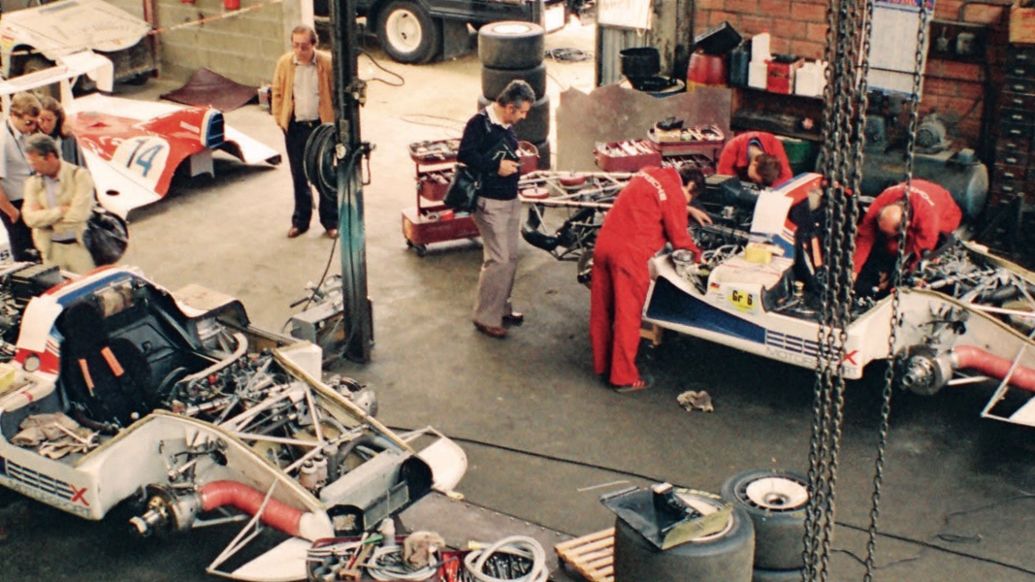
“The atmosphere at our workshop was both casual and highly professional.”
Porsche has had all manner of tragedies and triumphs in Le Mans, and no manufacturer has been more successful on the course near the Sarthe River. The photos reveal an unparalleled devotion to the iconic race.
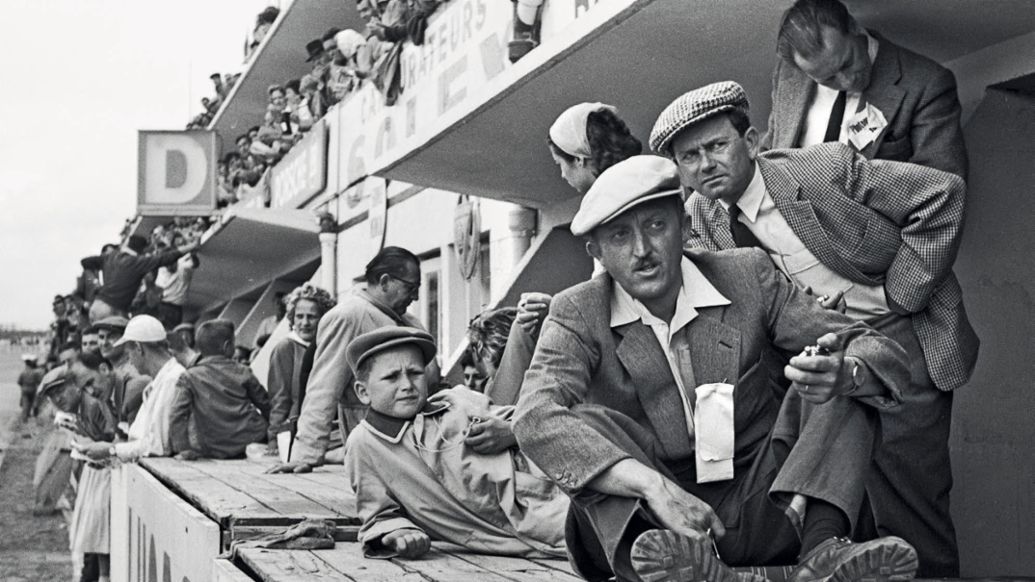
Since the very first appearance of two modified Porsche 356s in 1951, no year has passed without the presence of Porsche race cars driven by factory or customer teams. Which is why Le Mans is also known as “Porsche’s living room.”
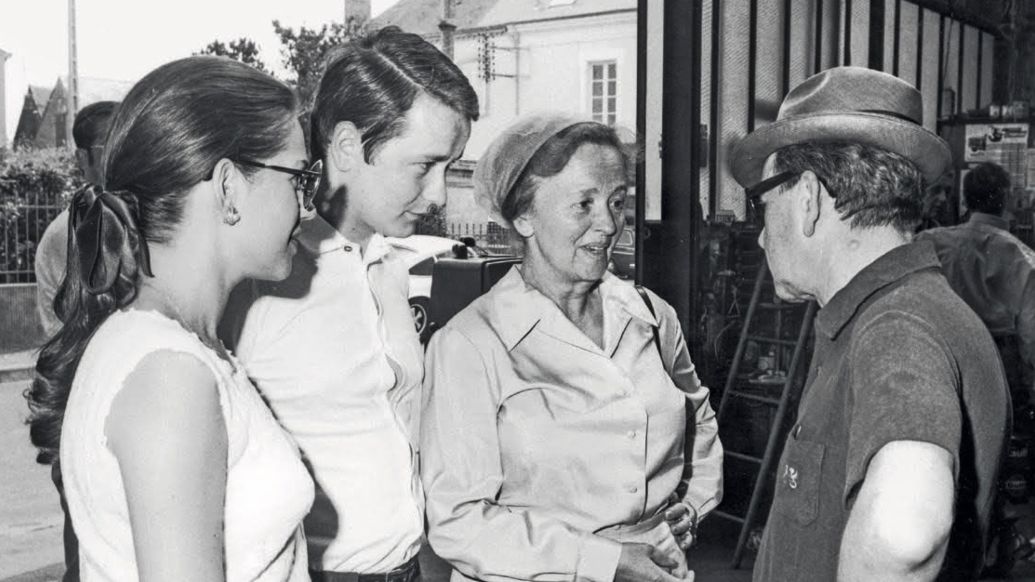
In a photo from 1970, Wolfgang Porsche spies his mother Dorothea, who didn’t regularly attend the epic race, next to his father, Ferry. That was the year of the eagerly awaited first overall Porsche victory by Hans Herrmann and Richard Attwood in the 917 short tail. A car and an event that Wolfgang Porsche will never forget. That win was a “phenomenal milestone,” he says. “It was the first time we showed we could beat the really big names. It was a breakthrough on the international stage.”
The Porsche DNA
The next half a century brought eighteen more overall victories—too many to list individually. The race in 1976 holds a special place in Wolfgang Porsche’s heart: the Porsche 936 was the first turbocharged car in history to win Le Mans. A few years into the energy crisis, debate was heating up in some countries over whether to ban cars, making this win all the more valuable. “We showed that turbos are fuel efficient and well engineered, which was crucial for the success of the production models.” Porsche had only recently introduced the 911 Turbo as its first road-going production car with a turbocharged engine.
“Racing remains fundamental to Porsche. It’s in our genes.”
Close connections between racing and production continued when Porsche sent a factory team back to the top LPM1 class of the world’s toughest endurance race in 2014. Three overall victories in a row—in 2015, 2016, and 2017—continued to fuel Porsche’s story of success, not only at Le Mans. The Porsche 919 Hybrid generated valuable expertise that went into developing hybrid production vehicles and Porsche’s first all-electric car, the Taycan.
Wolfgang Porsche spent those years cheering in the pit as well. “Racing remains fundamental to our brand. It’s in our genes,” he says. “And I’m happy to champion that cause in my position as Chairman of the Supervisory Board.”
Le Mans
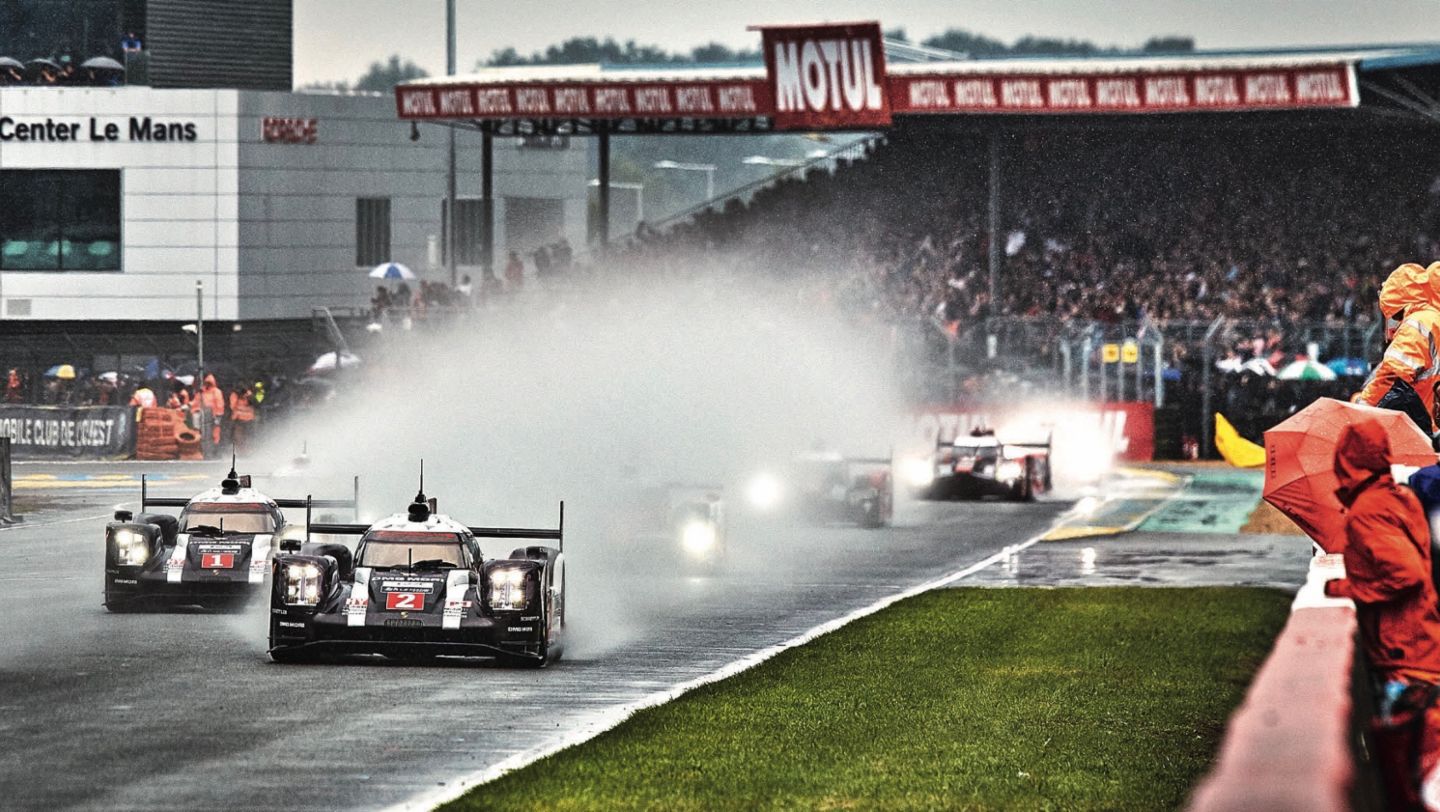


He was also there with his team at the dramatic end of the race in 2016, when Toyota appeared sure to win, only to be overtaken by Porsche literally in the final meters.
“Anything can happen in those twenty-four hours.”
In 2017 he and the team went through the emotional ups and downs that only a twenty-four-hour race can offer. More than an hour was needed to change the electric motor on the front axle of the 919 Hybrid with start number 2. “It felt like we took the whole car apart and put it back together,” he recalls.
With what appeared to be hopeless prospects in the fifth hour of the race, Earl Bamber, Timo Bernhard, and Brendon Hartley then embarked on an unbelievable comeback. “Just a few hours before it was over, our number 1, which was in the lead, had to leave the race, and then the two Toyotas did too,” he says.
Once again, he felt sorry for the rivals but also delight at what had seemed an impossible victory for the underdog trio. “Never give up—that’s the Porsche mindset. The race isn’t over until you cross the finish line.” Hang in there and be there when it counts. Despite the end of the LMP1 era, Wolfgang Porsche still comes to Le Mans whenever his schedule allows. “I’m excited about the performance of our GT cars,” he says. “That’s of great interest to me, because our customers drive in that class too. And nothing is more important to us than our customers.” Yes, Le Mans is a family affair—and every customer is part of the family.
Tuesday, June 16, 2020
Women who raced MGs during the 1930s: Doreen Evans
Doreen raced at Brooklands from the age of 17. Apart from Ivy Cummings, who was not an official competitor, she must have been one of the youngest women to drive on the Brooklands oval. Her next racing car was another MG, a Magna L-Type, and her first major event was the five-lap handicap at the 1934 BARC meeting, in July. A couple of weeks later, she was third again, in the Light Car Club’s annual relay race. She was part of a three-woman MG Magnette team backed by the MG factory. Her team-mates were Irene Schwedler and Margaret Allan. She finished one place above her brother, Kenneth, but failed to win the Ladies’ Prize, after the Singer team of Kay Petre, Eileen Ellison and Sheila Tolhurst exploited a loophole in the rules, stating that the Ladies’ Prize, and the Le Mans entry that went with it, could not be awarded to a team in the top three. They sandbagged and finished fifth. In October, Doreen won a Ladies’ Handicap on the Brooklands Mountain circuit in an MG Q-Type, defeating Fay Taylour and Bill Wisdom.
Using a rebodied version of the Q-Type, she won the Outer Circuit race at the Brooklands March meeting in 1935. In yet another MG, an R-Type, she and Kenneth entered the Brooklands 500 Mile race, but did not finish due to valve trouble.
Despite not winning the LCC Ladies’ Prize, she was part of the works MG team for Le Mans in the summer. George Eyston was managing a three-car ladies’ team of Midgets, all three of which finished. Doreen was in the middle in 25th, driving with Barbara Skinner. The team became known as “The Dancing Daughters”, perhaps after a radio show of a similar name.
Away from circuit racing, she competed in that year’s RAC Rally, driving an MG Magnette, and scored a class win. In May, secured the Ladies’ Record at the Shelsley Walsh hillclimb, driving the 750cc MG R-Type. In September, she was involved in a battle for that same record with Kay Petre, her rival who had risen to prominence at the same time. A mistake during the final run-off gave the award to Kay, in her White Riley.
In 1936, Doreen drove the R-Type at Brooklands, finishing third in the BARC Second Mountain Handicap. She entered the Brooklands International Trophy in the same car, but suffered a dramatic accident. Her car caught fire and crashed on the Members’ Banking, although she had slowed it sufficiently to allow herself to jump out. Although she suffered only minor injuries, the car was badly damaged. She was also scheduled to compete in the Tourist Trophy in an Aston Martin, but her team-mate, Alan Phipps, crashed out on the first lap, before she got the chance to drive.
Despite this setback, she married Phipps, and moved to America with him. Like her brother Denis, she stopped racing upon her marriage. Later, she earned her pilot’s license, and took up flying.
She died suddenly, at home in California, in 1982.
Friday, June 12, 2020
Famed Porsche Engineer Hans Mezger Dies at Age 90
Porsche owes him not only the Porsche 911's air-cooled, six-cylinder boxer engine but also the overall construction of the 917 and its twelve-cylinder engine as well as his creation of the TAG Turbo Formula One engine. For more than three decades, Hans Mezger was responsible for Porsche's most successful racing cars and engines. “The news of his death represents a very sad loss for us. Our thoughts are with his family,” says Michael Steiner, Member of the Executive Board, Research and Development. “We thank Hans Mezger for his extraordinary engineering achievements, which he has done for motorsport in general and for Porsche in particular. His innovations for our series sports cars will remain unforgotten forever.”
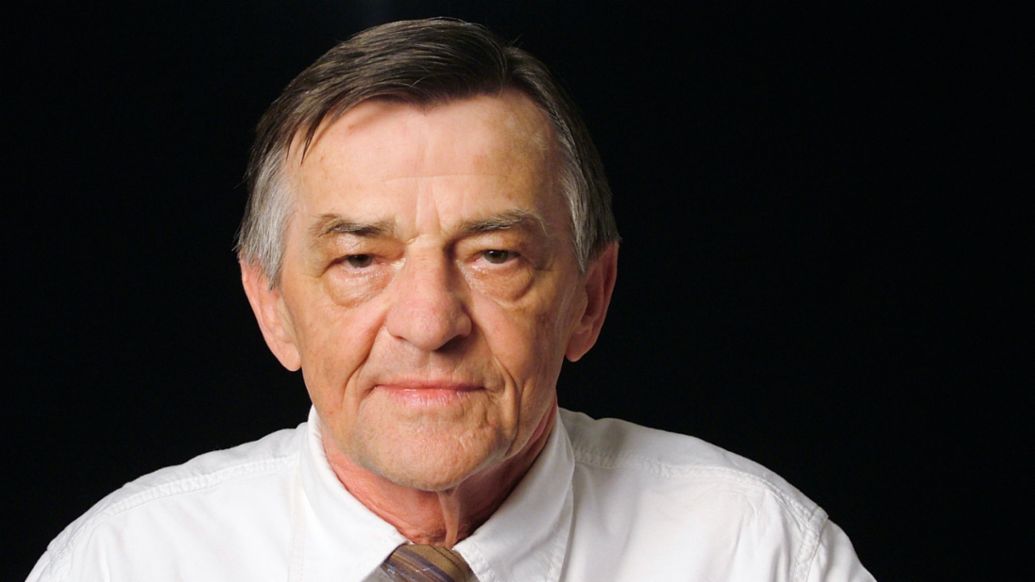
Hans Mezger was born on November 18, 1929 in Ottmarsheim, a small village near Ludwigsburg on the outskirts of Stuttgart. The youngest of five children, his parents ran a country inn. Art and culture were very important to the Mezger household. From an early age, aeroplanes and flying also fascinated the young Hans, and he occasionally undertook a trip to Kirchheim/Teck with a group of gliding enthusiasts from his neighbourhood.
Mezger continued his grammar school studies in Besigheim through the 6th grade, then followed by German A-levels in Ludwigsburg. "In 1946, I experienced my very first car race. It was at Hockenheim where old pre-war race cars lined up, along with Hans Stuck, whom I photographed with my old camera."
Hans Mezger decided to study mechanical engineering at the Technical University, now the University of Stuttgart. However, at this time the universities were very crowded because the young men who had returned from the war were given preferential treatment for admission. Hans Mezger used the university requirement for a twelve-month internship to practise numerous stages such as machining, welding, model making and a few weeks in the grey cast iron and aluminium foundry. "At that time I was riding a motor scooter, an NSU Lambretta. Apart from my brother’s 250 cc DKW it was my first and last motorised two-wheeler. I rode the Lambretta until 1960, when I bought my first car, an old and quite worn-out 356. It was not until years later that I came into contact with motorised two-wheelers again, when in the late 1970s it became necessary to develop new motorcycle engines for Harley-Davidson.”
He joined Porsche on October 1, 1956 in the calculation department.
After graduating in 1956 at the time of the German economic miracle, there was a veritable flood of job offers. “There were 28. But Porsche was not among them. I wanted to join Porsche because the Type 356 sports car inspired me. So I applied, got an interview, and the company offered me a job in diesel engine development. Until then, I didn’t even know that Porsche had such a thing. But I envisioned working on sports cars. They showed understanding and that's how I started in the calculations department at Porsche," said Hans Mezger about his start at the Zuffenhausen sports car manufacturer. A little later in 1958, Hans Mezger and his wife Helga got married. This was followed by the move to their first flat together in Ludwigsburg and, shortly afterwards, their two children, Daniela and Oliver.
Things then began happening one after the other. Hans Mezger gained his first experience with the four camshaft engine Type 547, developed a formula for calculating cam profiles and became part of Porsche's first Formula 1 project in 1960. He was involved in the development of the 1.5-litre eight-cylinder Type 753 as well as the corresponding chassis of the 804. “On this Formula 1 project I also learned a lot about the design of combustion chambers. This also directly benefited the design of the 6-cylinder boxer engine for the later 901/911. Ferry Porsche, with his visionary leadership of the company, his human qualities, dignity and great dedication, became my role model. I wholeheartedly shared his philosophy of racing in order to build the best sports car for the road, was impressive and had a lasting impact on myself and my work during the entire period I spent at the company," he reported from that early era at Porsche.
Design of the 911 engine and head of "Race car design"
His career included designing the world-famous “Mezger engine” for the 901 and 911 in the early 1960s. In 1965 Mezger was promoted to head of the department for race car design initiated by Ferdinand Piëch. This department was the key to a new quality and dynamism in motorsport for Porsche. It was an exciting, fascinating time in the mid-1960s. “Sometimes we also worked around the clock – like in 1965 when we created the Ollon-Villars Bergspyder in just 24 days and shortly thereafter the 910.” With its construction of a tubular frame, fibreglass body and design for new Formula 1 tyre technology, it became the blueprint for all the race cars that were built in the years to follow.
From the 917 to the TAG turbo for Formula 1
Porsche also relied on this design principle for the development of the 917 in 1968. With the 917, the first overall victory for Porsche at Le Mans was now finally possible, and once again Ferdinand Piëch relied on the skilfulness of Hans Mezger, who was responsible for the overall construction of the vehicle and its 12-cylinder engine. The 917 dominated at Le Mans and in the World Sportscar Championship in 1970 and 1971. In 1972 and 1973, and right from the start, the 917/10 and 917/30 showed good responsiveness even on the curvy stretches of the CanAm series, thanks to a novel exhaust turbocharging technology developed by Porsche itself. For the first time, turbocharging was successfully given a responsiveness that allowed racing cars and series-production vehicles to be used on all race tracks and public roads. A technology that makes Porsche a pioneer in this field and Mezger and his team brought to series production in 1974 in the form of the 911 Turbo. Many other victorious developments followed: for the 24 Hours of Le Mans, the World Sportscar Championship and the US Indy series.

But perhaps the most outstanding project took off in 1981 when Ron Dennis and his McLaren racing team set out in search of a powerful turbo engine for Formula 1. In the end, Porsche was chosen and the decision was made to design and build a completely new engine, as well as to provide on-site support during the races. Again, Hans Mezger was the creative mastermind behind the 1.5-litre, V6 engine with an 80-degree bank angle, which would later produce more than 1000 PS. In 1984, Niki Lauda became world champion with it, and again in 1985, followed in 1986 by Alain Prost. The TAG Turbo won a total of 25 races, plus the two Constructors' World Championships in 1984 and 1985. "This was a resounding success and also the most significant development contract for Porsche from an external company.
Always closely connected to Porsche
His commitment to Porsche has made him reject all offers from other manufacturers throughout his career and he still owned his 911 Carrera 3.0 in Grand Prix white – a coveted Porsche classic which has "his" engine. His loyalty and connection to Porsche was unbroken. He was available to journalists, technicians and interested fans as a discussion partner. The Porsche Museum hosted a celebration for his 90th birthday with family, friends and former companions. He accompanied Porsche at events, trade fairs and festivities until the very end.
Career and highlights at Porsche
1956–1960 Technical calculation department in the design department. Responsible for valve control of all engines, among other things.
1960–1962 Move to the Porsche Formula 1 project team. Collaboration in engine and chassis design.
1963 Design of the 901/911 engine. Responsible for design and further development of all racing engines.
1965 Design and project management of the Ollon-Villars Spyder. Management of the newly established department for race car design.
1966–1970 Design of the 910, 907, 908, 917, 2-litre four-cylinder engine for the 914 production sports car.
1971–1973 CanAm race cars 917/10 and 917/30 with turbocharging.
1974–1976 Design, development and further development of six-cylinder turbo engines and the Type 935 and 936 race cars.
1977–1978 Development of the water cooling and four-valve concept for the Type 935 and 936 six-cylinder turbo engines.
1977–1980 Design of the four-cylinder engine for Harley-Davidson. Development of the Indy engine based on the Type 935/936. Further development of the 935/936 race cars and engines.
1981–1982 Development of a 2.65-litre engine based on the 935/936 for Group C (956/962).
1981–1987 Design, overall project management and further development of the "TAG-Turbo – made by Porsche" Formula 1 engine.
1987–1988 Design of the Type 2708 Indy 2.65-litre engine.
1990 Design of the Type 3512 12-cylinder Formula 1 engine
Honours and awards
1974 The Starley Premium Award (GB) for the best automotive presentation of the year on the Porsche Type 917.
1984 Behind the Scenes Award (USA) for the development of the TAG Turbo Formula 1 engine.
1984 Trofeo Colin Chapman (I) for the development of the TAG Turbo Formula 1 engine.
1984 Prince Metternich Prize (D) for outstanding technical achievements in motorsport.
1984 Trophée de L'Exploit (F) for the development of the TAG Turbo Formula 1 engine.
1984 Caschi d'Oro (I) for winning the Formula 1 Constructors' World Championship (presented to McLaren).
1985 Prof. Ferdinand-Porsche Award (A) of the technical university Vienna in recognition for the accomplishment of developing the combustion engine. Hans Mezger is still the only person from the Porsche company to have won this award.
1987 Médaille Spéciale (F) for the development of the TAG Turbo Formula 1 engine.

















